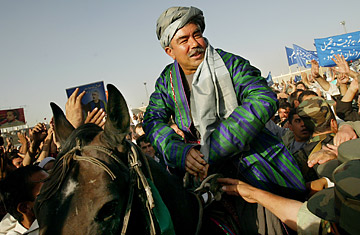
(2 of 3)
A former NATO official in Afghanistan compares the warlords to shrapnel lodged in an artery: Infection is a risk, he says, but pulling it out could be even worse. "There are so many other things we have to worry about, so why go and open this can of worms?" he asks. In some areas, tackling the militias can backfire. In the northeastern province of Badakhshan, local commander Nazir Mohammad runs the provincial capital, Faizabad, as one big protection racket. Foreign humanitarian organizations that don't hire his security services face attacks. When organizers at the German-run regional military-assistance base attempted to dismiss his men because of a compelling accusation of murder, the base was firebombed; Taliban militants were blamed even though they are not known to operate in that area. Says a former prosecutor at the Attorney General's office: "Mohammad is such a powerful person in Badakhshan that he can cause many problems if his demands are not answered--even rocket attacks and roadside bombs." Mohammad, whose militia provides security for NATO troops and aid organizations, denies threatening groups that don't hire his services. "Why should I do that?" he asks. "I know they are here to rebuild Afghanistan. I am just trying to find [my guys] jobs."
The Afghan government seems largely unwilling to curtail the power of the warlords, whose wealth and influence have only increased in the new Afghanistan. These days, Dostum strides across the marble-inlay floors of his new mansion--a pink, three-tiered wedding cake of a house. The foyer boasts a massive aquarium stocked with exotic fish, next to a life-size portrait of Dostum standing beside U.S. General Tommy Franks. During a visit by TIME, workmen were putting the final touches on an immense gold-painted crown that spans the compound's entry gate. The crown was modeled on that of the 14th century Central Asian military conqueror Tamerlane. The money to build the house, Dostum says, came from Afghan President Hamid Karzai, for whom he was military chief of staff. According to Dostum, Karzai pays him $80,000 a month to serve as his emissary to the northern provinces. "I asked for a year up front in cash so that I could build my dream house," he says.
Karzai, through a spokesman, has refused to comment on his association with Dostum. Nevertheless, he may see buying Dostum's loyalty as a worthwhile investment. A presidential election is scheduled for the fall, and waning support from Afghans and the international community alike means that Karzai is far from guaranteed another term. Dostum, with his influence in the north, could prove a necessary if unpleasant ally.
Back Where We Started
This is not the first time warlords have held power in Afghanistan. After the 1989 withdrawal of Soviet troops, rival mujahedin groups that had united to drive out the foreigners turned on one another in a brutal civil war. The government collapsed, and militia commanders were able to seize territory and terrorize the population. The Taliban capitalized on widespread disgust with the warlords' savagery, coming to power in 1996. After Sept. 11, the U.S. relied on the northern warlords and their militias to help oust the Taliban. Many of those leaders were given prominent positions when the new Afghan government was formed, enabling them to claw back credibility that had been lost because of their behavior in the civil war.
